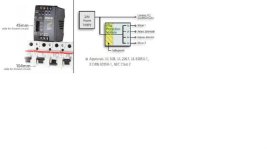NetNathan, sorry I didn't see your reply, I haven't been receiving all my email notifications from the forum.
NetNathan said:
...I know it current limits to maintain voltage and I may use one but I sill have to put in circuit protection (CB or fuse) for UL...
Just to be clear...
The PISA unit is not a power supply unit, it's a protection module. It replaces circuit breakers, standard fuses, or electronic fuses, that you would normally have on your PSU's distributed outputs. Overcurrent and short circuit protection is its primary function.
PULS PISA said:
Approvals: UL 508, UL 2367, UL 60950-1, IEC/EN 60950-1, NEC Class 2
The PISA is a fully certified overcurrent and short circuit module. UL should have no issues with you using it after the main PSU as a substitute for circuit breakers.
Its secondary features are the input voltage monitoring and output active current limiting to protect the main PSU's other sensitive loads. If one of its outputs draws too much current it is tripped immediately, allowing its other outputs to remain active, and the other loads directly off the PSU. Same for a sustained short. It's like having separate circuit breakers or fuses on each output, but with the added bonus of protection against faults back to the main PSU.
PULS PISA said:
If necessary, the wires to these loads can be protected using standard miniature circuit breakers or lead fuses.
If you have to seperate out any of the PISA outputs to more than one device, then I would use fused terminals in the panel before the field wiring. You would normally fit a circuit breaker or fuse local to the output devices out in the field, such as Panelviews, or other instrumentation. This is for discrimination, isolation, and protection of the cable run.
NetNathan said:
I still think they should have added some isolation between outputs.
Do you mean noise filtering or do you mean make/break isolation?
Filtering:
Noise immunity between the outputs or to the outside world is not mentioned specifically, but it is a certified advanced electronic fuse unit. I'm sure they would have incorporated good noise/EMC suppression and or tracking isolation. You would have to ask this from your distributor.
Isolation:
There is an ON/OFF input for enabling and disabling the PISA module. Whether you can isolate each output individually or not, I'm not sure from the literature? I would imagine you can, but again you would have to ask. As the PISA is acting as the circuit breaker, as I mentioned above, a fused terminals would suffice directly after the outputs, and before the field wiring. There is also a reset input for a controlled reset or a manual button on the module.
NetNathan said:
I believe the Digital I/O PS will be the noisy line (break of switch contacts, coils spikes...etc) and the Analog may suffer from voltage dips caused by "power up" load from instrumentation..... without using an oversize power supply.
For your setup, I would use one PSU, large enough to carry the total load of the installation, no more. Place the sensitive loads such as, Analog, PLCs, safety circuits, directly off this PSU, through their normal circuit breakers or fuses.
Supply the PISA directly from the PSU and place the Digital I/O, instrumentation, panelview and POINT I/O on the PISA's outputs.
No inrush current or faults on the PISA's outputs will affect the Analog or PLCs' supply.
I don't think you need to put the panelview on it's own PSU, the PISA should handle it ok. It is what it is designed for. The PISA saves you needing more than one PSU, but if you feel the total load is too great for one PSU, then consider a second for load sharing.
The PISA also saves you using an oversized PSU. Because it limits the overload current on its outputs, it never overloads the main PSU beyond its normal rated capacity. Normally, you would have to select an oversized current rating on the PSU, beyond the installations' maximum capacity, to allow for any potential overcurrent.
NetNathan, I have not used these units, but knowing how good PULS are, I would recommend it. It would appear to suit your needs, or something similar to it.
I will definitely try one if the need arises.
But what do they cost?
This may have a bearing on your choice.
G.







